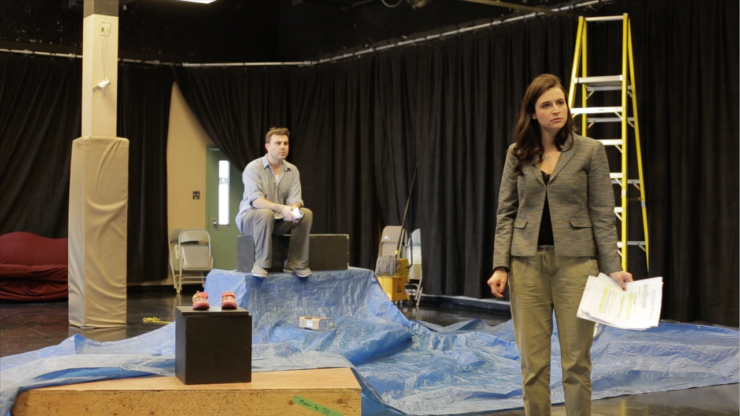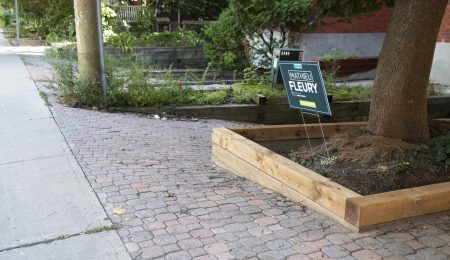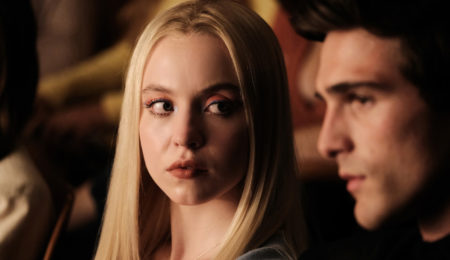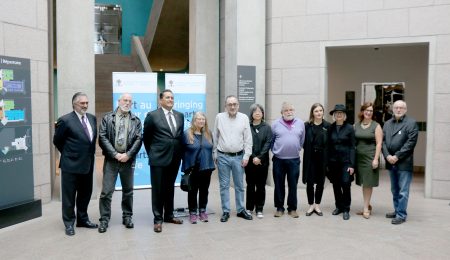Eclectic, experimental undercurrents festival runs until Feb. 17
Little Boxes
Ever felt like you were alive but not really living, just watching life pass you by? If so, then this play may be for you.
On the second day of its programming, the undercurrents festival showcased the world premiere of Little Boxes at the Arts Court Theatre on Thursday, Feb. 8.
The 65-minute play, created by Gabrielle Lazarovitz and Brad Long and directed by Adam Paolozza, takes us into the passive suburban world of Paul (Carter Hayden) and Lauren (Gabrielle Lazarovitz), a young married couple who are faced with a moral dilemma following a traumatic accident behind the wheel.
Little Boxes is centred around the car’s front seats, street lamps, and a pair of shoes found at the scene of the crash. The story is presented in little vignettes, jumping from fantasies of the future and nostalgic memories of the past to the horrifying reality of their present oversight. The swift shifts in mood and lighting are abrupt but not misplaced, echoing how the joys of Paul and Lauren’s younger years collide with the crippling anxiety of adulthood. The pair of shoes left at the front of the stage also do well to bridge the play’s theme of lost innocence, as well as the protagonists’ realization that they may resemble their loathed neighbors more than they realized.
Young adult audiences can appreciate the nods to the Sega Genesis gaming console, high school crushes, and other references to relics from the past, as well as discussions on underemployment, student loan debt, and the housing crisis. That said, the play’s overarching motif of negotiating and reconciling the past with the present and future drew a crowd of both young and old on opening night.
As a whole, the undercurrents festival, produced by Ottawa Fringe, lives by its tagline: “Theatre Below the Mainstream.” Theatre connoisseurs and amateurs alike can appreciate the smaller, more intimate venues, affordable prices, drinks, volunteer staff, and innovative contemporary plays.
Little Boxes runs at the Arts Court Theatre until the end of the festival on Saturday, Feb. 17. undercurrents has a new pay-what-you-can option for students with the presentation of a valid student card.
—Candide Uyanze, Fulcrum contributor
The Pipeline Project
The Pipeline Project is a powerful, emotional, and educational performance that will leave you with a deeper and more nuanced understanding of the context surrounding the British Columbia oil pipeline projects.
The play features three people who come together to work on a group project: two Indigenous people and a white man. The conversation moves to land claims and, soon enough, the tension can be cut with a knife.
The Pipeline Project uses a combination of short vignettes, video clips, music, and monologues to guide the audience through the complicated issue of pipelines. The Indigenous characters, Kevin and Quelemia, slowly introduce Sebastien, the white character, to their culture and belief systems, which he struggles to understand. He, on the other hand, is righteously proud of his environmentalism but cannot understand why Kevin, Quelemia, and their First Nations communities are not willing to share their land with pipeline projects.
All three characters have their flaws, and struggle to reconcile their values of culture, community, and environmentalism with the big trucks, Styrofoam take-out containers, and other conveniences of modern life. From the opening scene, each character admits their faults, allowing the audience to be open to addressing topics like unceded territory in B.C., residential schools and colonialism, oil spills, and consumerism. In short, informative scenes, the three characters explain the historical background of B.C. and its original people.
The only flaw was that the performance would definitely appeal more to a British Columbian audience. Their examples were always B.C.-specific and were sometimes hard to understand if you were not familiar with the province. It would be even more relevant to the undercurrents audience if they offered some examples from Ontario as well.
This is a small criticism, however, for an otherwise beautiful performance. The play doesn’t solve the issues of pipelines, and you will walk away feeling conflicted, but this is a tribute to the performers’ expertly crafted scenes that leave no topic untouched.
—Janoah Willsie, staff contributor
The Twilight Parade
Among the more avant-garde pieces at this year’s undercurrents, The Twilight Parade is part video, part live performance, starring eight voice actors and a cast of papier mȃché puppets.
The play was a community project. The puppets were built by the people of Wakefield, Quebec, and the piece was designed and performed by STO Union, a theatre group based in the Outaouais region. Given the themes of community in the video, the method of its creation was fitting.
The main character is Darmagon, a dragon-like fairy. He lives with his family in a cloud-like world, and their only goal is to collect the love of humans and spin it into silvery chains to hold up their world.
Eventually, Darmagon discovers that his father is a human bartender, and so he travels to the human world to meet him. Darmagon soon finds a world lacking in love, and full of racism, anger, and mega-corporation privatization.
This is where the play runs into issues. At one point in the bar, Darmagon claims that he will make everyone fall in love so as to return home. That premise is quickly dropped in favour of a heavy-handed tale of racism and the dangers of privatization. The video wears its politics on its sleeve, and it’s sometimes obnoxiously on the nose. You get lines such as, “Well, what did you expect when you voted small government?” that are far too obvious. By the time ‘white man’ is hurled as an insult, it seems more cheesy than powerful.
In a way, the play has two different endings—the adventure in the human world ends when townspeople tear down the wall built around their well by the mega-corporation. The second, more fulfilling ending, is back in the fairy world, when Darmagon has the freedom and respect that he craved, free to travel to the human world looking for love to spin into beautiful threads.
Those plot issues aside, there is a lot to praise in The Twilight Parade. The voice actors are incredibly talented, making each puppet a unique character, and the videography was charming and easily sucked you into this fairy-tale adventure.
Overall, this is a unique adventure and experiment in puppetry that pushes the limits of an analog way of doing things that is anything but outdated.
—Ryan Pepper, arts & culture editor
Forstner and Fillister Present
A comedy with a serious message, this play about the fine art of woodworking was the most amusing on offer at this year’s undercurrents theatre festival.
The premise of the play was simple but original, with Forstner and Fillister—dedicated woodworkers—teaching a conference of fellow woodworkers (the audience) the tenets of “Wood first,” “soul furniture,” and fine craftsmanship. They would impart these skills by building a table without any power tools.
The piece doesn’t seem like much of a play. It opened with Forstner and Fillister handing out their business cards, before beginning their spiel about getting back to their roots and planting the seeds of a sustainable future through heritage woodworking skills like joinery, instead of the commercial woodworking so prevalent in the 21st century.
The main tension of the play was an overblown real-world debate, said the actors in a talk-back following the show—the issue of skilled craftsmanship over automation. In the play, the actors simplified the conflict for a non-woodworking audience, by making Forstner an avid advocate for using only manual tools, while his brother Fillister was open to using computers and power tools.
In the real world, everyone gladly uses power tools and computer technology—the actors, who did build a table using only manual tools, admitted it was sheer stupidity to not utilize technology. But there is a real debate over the part that automation is playing in the decline of traditional, skilled craftsmanship.
It should also be noted that the people who play Forstner and Fillister—Will Somers and Dave Mason—are real-life woodworkers, who met while studying cabinet-making at Algonquin College. The first iteration of Forstner and Fillister Presents was in 2014, in a 20-minute sketch in which the two gave lessons on how to craft a nightstand they had built for class.
In addition to the real-world issues of a declining craft, the play also dealt with the death of their father, who had cast a long shadow over them as a master woodworker himself. The spiritual presence of the father was both serious and comedic, and was inspired by a heart attack that Will’s father had the previous year.
All in all, Forstner and Fillister Presents is a comical play that deals with a laughable devotion to outdated craft, father issues, and sibling rivalry, while also seriously analyzing the death of a parent and the decline of skilled industry as automation takes over.
—Ryan Pepper, arts & culture editor
How to Disappear Completely
As the lights go down, “How to Disappear Completely” by Radiohead plays. The audience silently mouths the lyrics. The play of the same name begins.
How to Disappear Completely is a moving one-man production by award-winning lighting designer Itai Erdal, comprised of video footage and photographs he took during his mother’s last days on Earth. He presents these live, giving context and emotion to the documents.
The curtains open on a video from 2000 of Erdal’s mother at the beach. Erdal films her discussing the meaning of “having a harsh life.” That year, she was diagnosed with terminal lung cancer. As soon as Erdal learned the news, he flew back to Israel to spend the remaining time by her side, documenting her last months.
In this first video, she has nine months left to live. Eighteen years later, Erdal is alone on the stage and faces us, vulnerable yet brave. He says that he is not an actor, that he is a lighting designer for the stage and a very good storyteller. He brings these storytelling abilities to the fore in this production.
From loving his mom to helping her end her days, Erdal contrasts on stage the ephemeral art of lighting to the documentary captured on tape. Lulled by the mother’s story, the audience understands how every moment counts, just as much as how every per cent of a light’s intensity counts in the theatre.
“Every story is about Love or Death,” Erdal quotes from his mother. In the intimacy of the theatre, he engages with the audience, initiating a conversation on life and death. While this monologue could have easily romanticized death or even expressed its fatality, it is performed with humour and optimism.
The play is both simple in its words and elaborate in its staging and narrative construction. By presenting the art of theatre lighting to the audience, Erdal creates on stage a physical metaphor for life. The lighting determines the pace of the storytelling and takes part in Erdal’s conversation with the audience and his documentary screened behind him. Since the opening of the play, the audience knows the outcome. Yet the “harsh reality” somehow catches us off-guard, symbolized by Erdal manually unplugging the light present on stage.
By the end of the story, the audience becomes an extension of Erdal’s family, as much as he is an extension of his mother. And as we leave the theatre, we realize every single thing we take for granted is ephemeral; it won’t last forever. This play is an ode to life, love, and death, and urges us to enjoy fully the time we have.
—Mathilde Schöpfel, Fulcrum contributor
Coverage of undercurrents festival will continue until Feb. 17.





